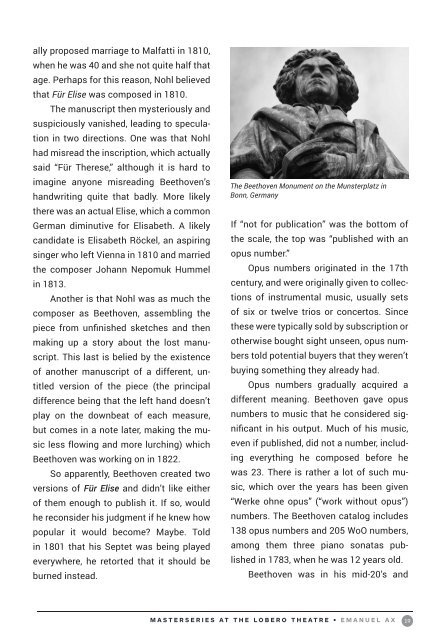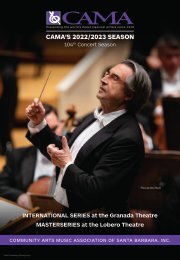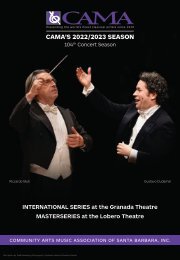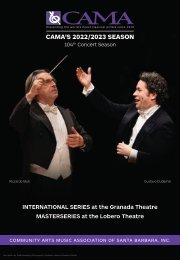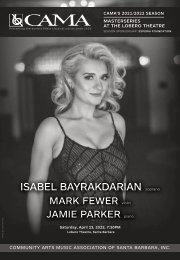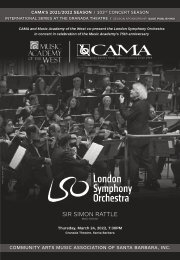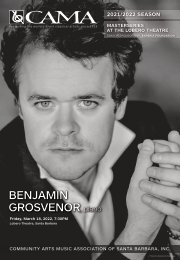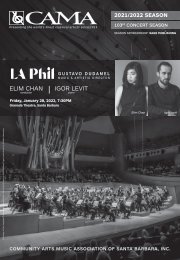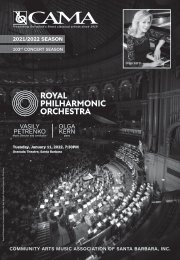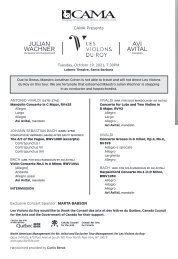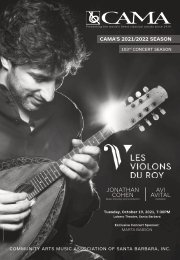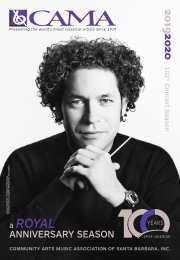January 13, 2020—Emanuel Ax plays Beethoven—CAMA's Masterseries—Lobero Theatre, Santa Barbara, California
Monday, January 13, 2020, 8:00PM Emanuel Ax, piano Few American pianists are as accomplished as the masterful Emanuel Ax. Between 1986 and 1996, Ax was awarded five Grammy® Awards for Best Chamber Music Performance for his collaborations with Yo-Yo Ma, Jaime Laredo, Isaac Stern and Richard Stoltzman. Additionally, Ax has twice been recognized for his solo work, winning the Grammy® Award for Best Instrumental Soloist Performance (without orchestra) in 1995 and 2004. Ax’s all-Beethoven recital focuses on widely and lesser known masterpieces of the iconic master’s large piano canon in celebration of the 250th Anniversary of Beethoven’s birth in Bonn, Germany in 1770. ALL-BEETHOVEN PROGRAM: Bagatelle No.25 in A Minor (WoO 59, Bia 515), “Für Elise” Piano Sonata in A Major, Op.2, No.2 Six Variations on an original theme in F Major, Op.34 Piano Sonata in F Minor, Op.2, No.1 Five Variations on “Rule, Britannia!,” WoO 79 Piano Sonata in C Major, Op.2, No.3 #CAMASB #CAMA101 #EmanuelAx #Beethoven
Monday, January 13, 2020, 8:00PM
Emanuel Ax, piano
Few American pianists are as accomplished as the masterful Emanuel Ax. Between 1986 and 1996, Ax was awarded five Grammy® Awards for Best Chamber Music Performance for his collaborations with Yo-Yo Ma, Jaime Laredo, Isaac Stern and Richard Stoltzman. Additionally, Ax has twice been recognized for his solo work, winning the Grammy® Award for Best Instrumental Soloist Performance (without orchestra) in 1995 and 2004. Ax’s all-Beethoven recital focuses on widely and lesser known masterpieces of the iconic master’s large piano canon in celebration of the 250th Anniversary of Beethoven’s birth in Bonn, Germany in 1770.
ALL-BEETHOVEN PROGRAM:
Bagatelle No.25 in A Minor (WoO 59, Bia 515), “Für Elise”
Piano Sonata in A Major, Op.2, No.2
Six Variations on an original theme in F Major, Op.34
Piano Sonata in F Minor, Op.2, No.1
Five Variations on “Rule, Britannia!,” WoO 79
Piano Sonata in C Major, Op.2, No.3
#CAMASB #CAMA101 #EmanuelAx #Beethoven
You also want an ePaper? Increase the reach of your titles
YUMPU automatically turns print PDFs into web optimized ePapers that Google loves.
ally proposed marriage to Malfatti in 1810,<br />
when he was 40 and she not quite half that<br />
age. Perhaps for this reason, Nohl believed<br />
that Für Elise was composed in 1810.<br />
The manuscript then mysteriously and<br />
suspiciously vanished, leading to speculation<br />
in two directions. One was that Nohl<br />
had misread the inscription, which actually<br />
said “Für Therese,” although it is hard to<br />
imagine anyone misreading Beethoven’s<br />
handwriting quite that badly. More likely<br />
there was an actual Elise, which a common<br />
German diminutive for Elisabeth. A likely<br />
candidate is Elisabeth Röckel, an aspiring<br />
singer who left Vienna in 1810 and married<br />
the composer Johann Nepomuk Hummel<br />
in 18<strong>13</strong>.<br />
Another is that Nohl was as much the<br />
composer as Beethoven, assembling the<br />
piece from unfinished sketches and then<br />
making up a story about the lost manuscript.<br />
This last is belied by the existence<br />
of another manuscript of a different, untitled<br />
version of the piece (the principal<br />
difference being that the left hand doesn’t<br />
play on the downbeat of each measure,<br />
but comes in a note later, making the music<br />
less flowing and more lurching) which<br />
Beethoven was working on in 1822.<br />
So apparently, Beethoven created two<br />
versions of Für Elise and didn’t like either<br />
of them enough to publish it. If so, would<br />
he reconsider his judgment if he knew how<br />
popular it would become? Maybe. Told<br />
in 1801 that his Septet was being played<br />
everywhere, he retorted that it should be<br />
burned instead.<br />
The Beethoven Monument on the Munsterplatz in<br />
Bonn, Germany<br />
If “not for publication” was the bottom of<br />
the scale, the top was “published with an<br />
opus number.”<br />
Opus numbers originated in the 17th<br />
century, and were originally given to collections<br />
of instrumental music, usually sets<br />
of six or twelve trios or concertos. Since<br />
these were typically sold by subscription or<br />
otherwise bought sight unseen, opus numbers<br />
told potential buyers that they weren’t<br />
buying something they already had.<br />
Opus numbers gradually acquired a<br />
different meaning. Beethoven gave opus<br />
numbers to music that he considered significant<br />
in his output. Much of his music,<br />
even if published, did not a number, including<br />
everything he composed before he<br />
was 23. There is rather a lot of such music,<br />
which over the years has been given<br />
“Werke ohne opus” (“work without opus”)<br />
numbers. The Beethoven catalog includes<br />
<strong>13</strong>8 opus numbers and 205 WoO numbers,<br />
among them three piano sonatas published<br />
in 1783, when he was 12 years old.<br />
Beethoven was in his mid-20’s and<br />
MASTERSERIES AT THE LOBERO THEATRE • EMANUEL AX<br />
19


